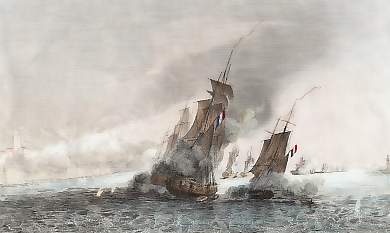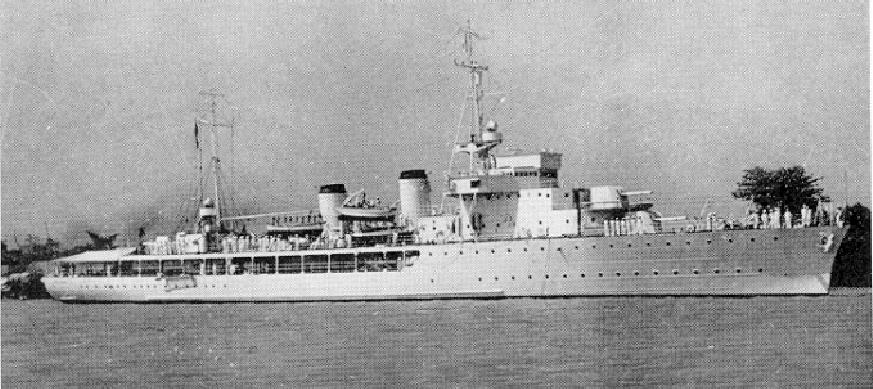|
French Corvette Diligente (1801)
''Diligente'' was a 20-gun corvette of the French Navy, lead ship of her class. Built at Brest on private plans by Pierre Ozanne, she was particularly fast. The French Navy adopted the design and copied the plans as late as 1848. Originally armed with 6-pounder guns, she was later rearmed with heavier carronades. She continued in service, off and on, until she was struck in 1854. Service history French Revolutionary and Napoleonic Wars ''Diligente'' took part in the Atlantic campaign of 1806 in Leissègues' squadron, culminating in the Battle of San Domingo. The frigates , , and ''Diligente'' captured and burned the American vessel ''Lark'', Moore, master, which was sailing from Philadelphia to Jamaica. In August 1808 ''Diligente'', captained by Commander Jean-François Lemaresquier, with the corvettes and ''Espiègle'', sailed from France with supplies for the island of Martinique. British ships chased the group through the Bay of Biscay and captured ''Sylphe'' and ''Esp ... [...More Info...] [...Related Items...] OR: [Wikipedia] [Google] [Baidu] |
Carronade
A carronade is a short, smoothbore, cast-iron cannon which was used by the Royal Navy. It was first produced by the Carron Company, an ironworks in Falkirk, Scotland, and was used from the mid-18th century to the mid-19th century. Its main function was to serve as a powerful, short-range, anti-ship and anti-crew weapon. The technology behind the carronade was greater dimensional precision, with the shot fitting more closely in the barrel thus transmitting more of the propellant charge's energy to the projectile, allowing a lighter gun using less gunpowder to be effective. Carronades were initially found to be very successful, but they eventually disappeared as naval artillery advanced, with the introduction of rifling and consequent change in the shape of the projectile, exploding shells replacing solid shot, and naval engagements being fought at longer ranges. History The carronade was designed as a short-range naval weapon with a low muzzle velocity for merchant ships, b ... [...More Info...] [...Related Items...] OR: [Wikipedia] [Google] [Baidu] |
Lorient
Lorient (; ) is a town (''Communes of France, commune'') and Port, seaport in the Morbihan Departments of France, department of Brittany (administrative region), Brittany in western France. History Prehistory and classical antiquity Beginning around 3000 BC, settlements in the area of Lorient are attested by the presence of Megalith, megalithic architecture. Ruins of Roman roads (linking Vannes to Quimper and Port-Louis, Morbihan, Port-Louis to Carhaix) confirm Gallo-Roman presence. Founding In 1664, Jean-Baptiste Colbert founded the French East Indies Company. In June 1666, an Ordonnance, ordinance of Louis XIV of France, Louis XIV granted lands of Port-Louis, Morbihan, Port-Louis to the company, along with Faouédic on the other side of the roadstead. One of its directors, Denis Langlois, bought lands at the confluence of the Scorff and the Blavet rivers, and built slipways. At first, it only served as a subsidiary of Port-Louis, where offices and warehouses were loc ... [...More Info...] [...Related Items...] OR: [Wikipedia] [Google] [Baidu] |
Age Of Sail Corvettes Of France
Age or AGE may refer to: Time and its effects * Age, the amount of time someone or something has been alive or has existed ** East Asian age reckoning, an Asian system of marking age starting at 1 * Ageing or aging, the process of becoming older ** Senescence, the gradual deterioration of biological function with age ** Human development (biology) * Periodization, the process of categorizing the past into discrete named blocks of time ** Ages of Man, the stages of human existence on the Earth according to Greek mythology and its subsequent Roman interpretation **Prehistoric age Prehistory, also known as pre-literary history, is the period of human history between the use of the first stone tools by hominins 3.3 million years ago and the beginning of recorded history with the invention of writing systems. The use of ... Places * AGE, the IATA airport code for Wangerooge Airfield, in Lower Saxony, Germany People * Åge, a given name * Aage, a given name * Agenore Incrocci, ... [...More Info...] [...Related Items...] OR: [Wikipedia] [Google] [Baidu] |
3 September 1843 Revolution
The 3 September 1843 Revolution ( el, Επανάσταση της 3ης Σεπτεμβρίου 1843; N.S. 15 September), was an uprising by the Hellenic Army in Athens, supported by large sections of the people, against the autocratic rule of King Otto. The rebels, led by veterans of the Greek War of Independence, demanded the granting of a constitution and the departure of the Bavarian officials that dominated the government. The revolution succeeded, ushering the period of constitutional monarchy (under the 1844 constitution) and universal suffrage in Greece. Background During the War of Independence, the Greek rebels had passed a series of liberal and progressive constitutions on which the war's provisional governments were based. With the establishment of the monarchy in 1832 and the arrival of the Bavarian prince Otto as king, however, these liberal institutions were discarded. For the next 10 years, Otto and his mainly Bavarian officials would rule in an autocratic man ... [...More Info...] [...Related Items...] OR: [Wikipedia] [Google] [Baidu] |
Livorno
Livorno () is a port city on the Ligurian Sea on the western coast of Tuscany, Italy. It is the capital of the Province of Livorno, having a population of 158,493 residents in December 2017. It is traditionally known in English as Leghorn (pronounced , "Leghorn" in the . or ). During the , Livorno was designed as an "". Developing c ... [...More Info...] [...Related Items...] OR: [Wikipedia] [Google] [Baidu] |
July Monarchy
The July Monarchy (french: Monarchie de Juillet), officially the Kingdom of France (french: Royaume de France), was a liberal constitutional monarchy in France under , starting on 26 July 1830, with the July Revolution of 1830, and ending 23 February 1848, with the Revolution of 1848. It marks the end of the Bourbon Restoration (1814–1830). It began with the overthrow of the conservative government of Charles X, the last king of the House of Bourbon. , a member of the more liberal Orléans branch of the House of Bourbon, proclaimed himself as ("King of the French") rather than "King of France", emphasizing the popular origins of his reign. The king promised to follow the ''juste milieu'', or the middle-of-the-road, avoiding the extremes of both the conservative supporters of Charles X and radicals on the left. The July Monarchy was dominated by wealthy bourgeoisie and numerous former Napoleonic officials. It followed conservative policies, especially under the influence ... [...More Info...] [...Related Items...] OR: [Wikipedia] [Google] [Baidu] |
Battle Of The Tagus
The Battle of the Tagus was a naval engagement that took place on 11 July 1831 at the mouth of the Tagus river, in Portugal. A French fleet attacked and subdued Portuguese fortifications at the entrance of the Tagus, with the aim to strong-arm the government of Miguel I into recognising the newly established Kingdom of the French. The damage to the forts defending access to the Tagus and the arrival of French warships at Lisbon forced the Portuguese to cave in and comply with French demands. Background The accession of King Miguel I to the throne of Portugal and abolition of the Constitutional Charter had put the country under the rule of an absolutist monarch. Liberals challenged his rule, and the struggle of the Liberal Wars ensued. The government of Miguel I was hostile to France, and became even more so when the popular insurrection of the July Revolution deposed the absolutist Bourbon king Charles X, and established a constitutional monarchy in which Louis-Philippe had ... [...More Info...] [...Related Items...] OR: [Wikipedia] [Google] [Baidu] |
Tagus
The Tagus ( ; es, Tajo ; pt, Tejo ; see #Name, below) is the longest river in the Iberian Peninsula. The river rises in the Montes Universales near Teruel, in mid-eastern Spain, flows , generally west with two main south-westward sections, to empty into the Atlantic Ocean in Lisbon. Its Tagus Basin, drainage basin covers – exceeded in the peninsula only by the Douro. The river is highly used. Several dams and diversions supply drinking water to key population centres of central Spain and Portugal; dozens of hydroelectric stations create power. Between dams it follows a very constricted course, but after Castle of Almourol, Almourol, Portugal it has a wide alluvium, alluvial valley, floodplain, prone to flooding. Its mouth is a large estuary culminating at the major Port of Lisbon, port, and Portuguese capital, Lisbon. The source is specifically: in political geography, at the Fuente de García in the Frías de Albarracín municipality; in physical geography, within ... [...More Info...] [...Related Items...] OR: [Wikipedia] [Google] [Baidu] |
French Guiana
French Guiana ( or ; french: link=no, Guyane ; gcr, label=French Guianese Creole, Lagwiyann ) is an overseas departments and regions of France, overseas department/region and single territorial collectivity of France on the northern Atlantic Ocean, Atlantic coast of South America in the Guianas. It borders Brazil to the east and south and Suriname to the west. With a land area of , French Guiana is the second-largest Regions of France, region of France (more than one-seventh the size of Metropolitan France) and the largest Special member state territories and the European Union, outermost region within the European Union. It has a very low population density, with only . (Its population is less than that of Metropolitan France.) Half of its 294,436 inhabitants in 2022 lived in the metropolitan area of Cayenne, its Prefectures in France, capital. 98.9% of the land territory of French Guiana is covered by forests, a large part of which is Old-growth forest, primeval Tropical r ... [...More Info...] [...Related Items...] OR: [Wikipedia] [Google] [Baidu] |
Sloop
A sloop is a sailboat with a single mast typically having only one headsail in front of the mast and one mainsail aft of (behind) the mast. Such an arrangement is called a fore-and-aft rig, and can be rigged as a Bermuda rig with triangular sails fore and aft, or as a gaff-rig with triangular foresail(s) and a gaff rigged mainsail. Sailboats can be classified according to type of rig, and so a sailboat may be a sloop, catboat, cutter, ketch, yawl, or schooner. A sloop usually has only one headsail, although an exception is the Friendship sloop, which is usually gaff-rigged with a bowsprit and multiple headsails. If the vessel has two or more headsails, the term cutter may be used, especially if the mast is stepped further towards the back of the boat. When going before the wind, a sloop may carry a square-rigged topsail which will be hung from a topsail yard and be supported from below by a crossjack. This sail often has a large hollow foot, and this foot is sometimes fil ... [...More Info...] [...Related Items...] OR: [Wikipedia] [Google] [Baidu] |
Aviso
An ''aviso'' was originally a kind of dispatch boat or "advice boat", carrying orders before the development of effective remote communication. The term, derived from the Portuguese and Spanish word for "advice", "notice" or "warning", an ''aviso'', was later adopted by the French and Portuguese navies to classify their medium-sized warships designed for colonial service. The term continued to be used in the French Navy to classify the patrol frigates until 2012, when the remaining ships of the class were reclassified as offshore patrol ships. It is equivalent to the modern use of "sloop" in other countries. Description The ''Dictionnaire de la Marine Française 1788–1792'' (by Nicolas-Charles Romme) describes ''avisos'' as "small boats designed to carry orders or dispatches". This use became obsolete with the development of means of communicating detailed information at a distance. French ''avisos'' used during World War I and World War II had displacements of 300–7 ... [...More Info...] [...Related Items...] OR: [Wikipedia] [Google] [Baidu] |





.jpg)
